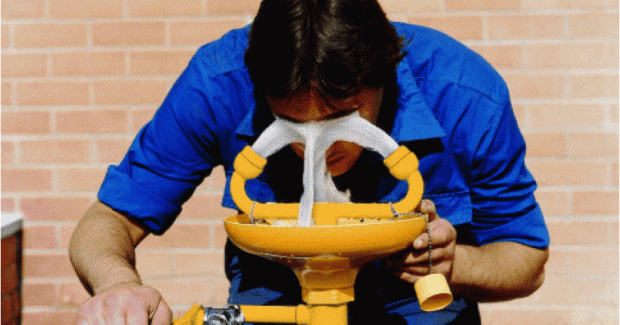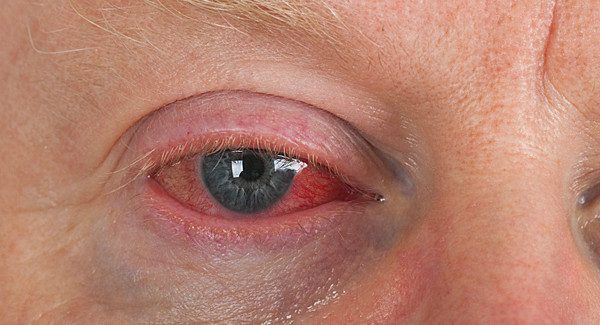How to Identify Safe and Effective Emergency Eyewash — and the Hidden Dangers to Avoid
While the FDA states that ophthalmic drug products should be sterile, ANSI does not require that emergency eyewash solution or its delivery mechanism be sterile. Yet the dangers of administering non-sterile eyewash can have profoundly negative impacts on injured individuals, as well as their employers.
Posted: January 27, 2014
A 2008 study by the Associated Press found that public drinking water for at least 41 million Americans was polluted with chemical contaminants. A study conducted by the Environmental Working Group (Washington, DC) found that water utilities nationwide detected more than 300 pollutants between 2004 and 2009. Many of the microorganisms and contaminants found in tap water can cause secondary injury and even vision loss when used in treating an already compromised eye.
Portable units
Portable eyewash stations are available in a variety of styles and sizes to meet nearly any facility’s needs. As their name implies, portable units can easily be moved and are compact enough to fit into nearly any workspace. Units with features such as alarms, view-through windows for easy maintenance and heated coverings for cold-weather applications make portable units easier than ever to install, use and maintain.
Because they are self-contained, portable eyewash units store and deliver preserved and/or pH-balanced water, saline solution or 100 percent sterile saline at room temperature for safe and comfortable flushing. The fluid in sealed-cartridge stations provides the longest shelf life – up to 24 months – and therefore such stations require the least frequent maintenance, involving monthly visual checks. Portable units containing buffered saline solution closely match the natural pH of the eye to protect it during flushing. Portable stations that deliver pH-balanced, buffered, 100 percent sterile saline offer unrivaled flushing safety.
Secondary or supplemental eyewash
Secondary, or supplemental, eyewash can be delivered in bottles or smaller portable stations. Secondary eyewash does not have the fluid capacity to flush both eyes at the rate of primary eyewash. Rather, ANSI states that supplemental eyewash “supports primary plumbed units, self-contained units or both by delivering immediate flushing fluid.” Secondary bottles or stations are required at the site of nuisance particles such as pollen, dust, sawdust and smoke as well as places where very caustic substances exist. In the case of electric storage battery handling, charging and maintenance areas where the extent of possible employee exposure to electrolytes is small, an eyewash device that contains no less than one gallon of water is an acceptable alternative to a primary station.
Secondary bottles and stations are well-suited for use in confined spaces that can’t accommodate a full-sized primary unit. Furthermore, secondary eyewash systems can be as critical for the treatment of an injured eye as their primary counterparts. In the case of chemical or caustic eye injury, eyewash bottles provide immediate treatment en route to a primary eyewash unit. They also provide continuous irrigation on the way to medical care. Available in a variety of sizes, personal eyewash bottles are small and highly portable, and can be made readily available at the site of any hazard.
NOT ALL FLUSHING FLUIDS ARE CREATED EQUAL
It is important to understand that — no matter how they are delivered — flushing fluids vary in many ways. They may be derived from tap, potable, purified or sterile water and they are offered in various end products ranging from concentrates or additives, which are added to water, to purified or sterile solutions that are premixed. Differences in ingredients and manufacturing processes also exist.
For these reasons, not all flushing fluids are created equal. Treating an injured eye with sub-standard fluid increases risk of irritation, allergic reaction or infection; can prolong the length of recovery; and can even lead to permanent vision loss for the affected individual. Such negative results can significantly impact an employer’s bottom line as well.
Not all flushing fluids are created equal. Treating an injured eye with substandard fluid increases risk of irritation, allergic reaction or infection; can prolong the length of recovery; and can even lead to permanent vision loss for the affected individual. Such negative results can significantly impact an employer’s bottom line as well.
When manufactured using poor-quality ingredients or large amounts of additives, non-sterile fluid can in fact be detrimental. For example, chemicals such as boric acid, benzalkonium chloride and benzethonium chloride are commonly used to kill bacteria or prevent its growth in non-sterile fluids or fluids that are not sterile from inception. These and other additives and preservatives have the potential to introduce harmful impurities, cause an allergic reaction, lengthen recovery and increase the chance of infection and disability.
EYEWASH REGULATION
Flushing fluid enters the body through an open orifice and can potentially introduce harmful elements; for this reason eyewash is regulated as an over-the-counter ophthalmic drug by the U.S. Food and Drug Administration (FDA). In Canada, emergency eyewash is regulated by Health Canada and is classified as a Medical Device and/or Natural Health Product. In most other countries emergency eyewash is also regulated by equivalent organizations. Aside from tap water, which is regulated by the Environmental Protection Agency (EPA) in the U.S., all forms of eyewash fluid must be registered with the FDA as an OTC ophthalmic drug.
Entities wishing to market eyewash in the U.S. may be manufacturers, distributors, repackagers, relabelers and foreign firms. In order to gain permission to do so, each entity must meet minimum requirements set forth by the FDA. The FDA requires that current good manufacturing practices are followed, and that the manufacture of fluids is conducted in accordance with that agency’s Quality Systems Regulation. Drug facts must be listed in a standardized fashion on the product’s label, and brand names and manufacturing information must be confirmed accurate.
Eyewash marketers and manufacturers are required to have a National Drug Code, or NDC, which is then listed on the FDA Web site. Entities wishing to change the brand name or the label must re-register with the FDA. This process ensures that purchasers and end-users can easily look up a drug’s compliance with FDA standards by searching for its NDC number, brand or product name, manufacturer name or by active ingredient on the FDA Web site.
HIDDEN DANGERS OF FLUSHING FLUIDS
Non-sterile solution
Despite government controls and oversight, there is a lot to look out for when selecting emergency eyewash. The most commonly used flushing fluids are not sterile and include concentrate, additive and purified water as well as saline. Yet the use of such fluids does not guarantee safe treatment, as most of these are left to the consumer to ensure proper mixing and measuring.
Furthermore, when manufactured using poor-quality ingredients or large amounts of additives, non-sterile fluid can in fact be detrimental. For example, chemicals such as boric acid, benzalkonium chloride and benzethonium chloride are commonly used to kill bacteria or prevent its growth in non-sterile fluids or fluids that are not sterile from inception. These and other additives and preservatives have the potential to introduce harmful impurities, cause an allergic reaction, lengthen recovery and increase the chance of infection and disability.
Regarding ophthalmic drug products, the U.S. Code of Federal Regulations (21 CFR 200.50) states, “The Food and Drug Administration concludes that all such preparations (offered or intended for ophthalmic use), if they are not sterile, fall below their professed standard of purity or quality and may be unsafe.”
















